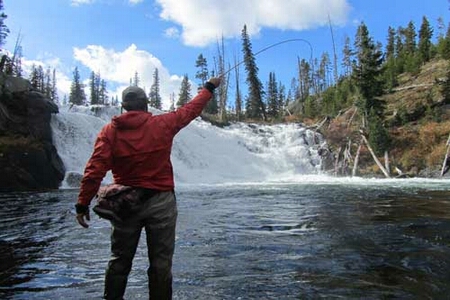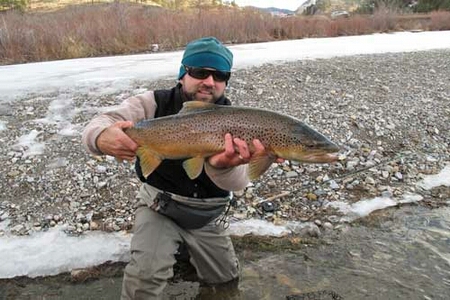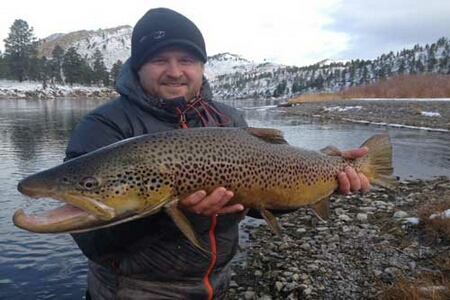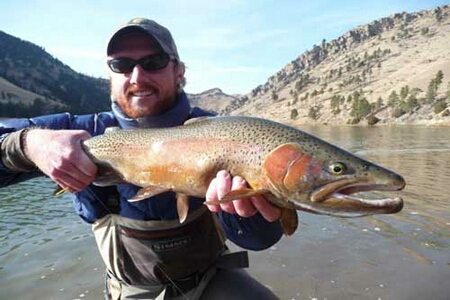
Fall fishing has a cult following in Montana. Die hard anglers visit the Big Sky state in October every year hoping to hook up with the fish of a lifetime. For a variety of reasons, most angler put their fall fishing eggs in the October basket and ignore the late fall. Rivers in November are virtually empty with most of the locals hunting and out of state anglers gone for the season. The truth is that November holds some of the very best fly fishing opportunities for huge fish both in Montana and in Yellowstone National Park. November certainly presents some risks for bad weather and early cold fronts and lodging options become more limited with most fishing lodges closing shop at the end of October. Our guides absolutely love November - partly because they finally get to fish on their own but also because it is the best month to catch the largest trout of the year. I get pretty nervous about steering guests towards a November trip due to the risk of weather, but for those folks travelling to Montana for other reasons or if you don’t mind colder weather November can be incredible.
The biggest draw of late season fishing is the chance at hooking the monster brown trout of a life time. Browns are fall spawners and let their guard down in October and November. While spawning begins as early as October the peak spawning month is November with some browns spawning into December. Not only do the big resident browns in rivers become more aggressive in the fall, but in many streams browns out of large lakes run into streams and rivers and suddenly become accessible. While there are still some 30” plus browns that reside year round in the Madison, Jefferson, Missouri, Yellowstone and a few others in the state - many of the big trout (we consider anything over 23” top be really, really big) spend their summers in lakes getting fat on large food supplies without fighting currents. These big lake run browns don’t show up until early October and continue moving into rivers well into November. Many of our guides are convinced that the biggest lake run browns are the last to enter the system. Keep in mind that we are not advocating fishing on redds (large “cleaned” gravel areas where trout lay and then protect their eggs), but simply recognizing that big browns are moving well into November and often not actually spawning until late November or even December.
Fall Run Hot Spots Large browns often do not run into small tributaries (although some do). Traditional fisheries like the Yellowstone River can still produce good fishing for browns. If you are looking for big lake run fish pick any reservoir on the map and give the river that feeds it a try in late October or November. Some better run fall run brown trout rivers include the Madison inside of Yellowstone Park, The Madison above Quake lake, The Madison near Ennis above Ennis Lake, The Missouri above Holter or Canyon Ferry Reservoirs, the Lewis Channel in Yellowstone and the Lewis River above Jackson Lake. Some of the tributaries of larger fisheries like the Yellowstone and Jefferson River can experience lesser known fall runs.
Where to Target Fall Run Fish Within The River It is important to find runs that “hold” browns during the fall run. For example on the legendary fall run out of Hebgen lake into the Madison in Yellowstone Park there are some stretches where the browns move through quickly and other runs where the fish seem to stack up, or stage, prior to the spawn. Sometimes you need to find these runs by trial and error but once you do they tend to produce season after season. Focus on main river features, look for larger runs with uniform currents and some depth. Also pay attention for obstacles that slow fish down like diversion dams or simply a long flat section upstream of a deeper run. Waterfalls and rapids are other locations that will force trout to stage prior to moving upriver.
 Targetting "stopping" points like waterfalls, diversions and other staging areas is always a good bet.
Targetting "stopping" points like waterfalls, diversions and other staging areas is always a good bet.
Flies and Techniques for Late Season Browns Keep in mind that big trout are in big rivers so bring your 6, 7 or even 8 weights in November. Both nymphing and swinging streamers can be productive. In my experience, float fishing with a traditional fast stripped streamer is not nearly as effective as targeting just a few “holding” runs and then getting out to wade and really work the productive water. Nymphing can be outstanding for late season fall run browns. The water is cold and the fish aren’t willing to move much. Make sure to get the flies right on the bottom so adjust the indicator and weight setup frequently. For fly selection egg patterns can be deadly in the late fall but also try baetis emergers and big stonefly nymphs. Fly selection isn’t as important as being in the right water and running your flies at the right depth. Takes are subtle so set at even the slightest reaction on the indicator. Switch rods are becoming increasingly popular for fall run browns in the bigger rivers. I think the ideal switch rod is just over 11’ with a 7 weight switch line. Switch lines are more “mendable” than traditional spey rod lines and much more effective for indicator nymphing. The longer rod also makes big mends easy when fishing large rivers where the biggest fall run fish can be found. On smaller tributary runs traditional 9’ size 6 or even 5wt rods are perfect.
Streamer fishing can still be productive in November but using more of a steelhead or salmon swing technique is better than aggressive stripping. The water is cold and the fish are becoming a bit lethargic due to depressed temperatures. A full sinking line like a Teeny style line with a shooting head over 20’ with 150-250 grain line is perfect depending on current speed and depth. I carry a 150, 200 and 250 grain line with me and switch frequently to find the right combination. Streamers tend to be most productive at dawn and dusk and even after dusk. Although water temps are warmest at mid-day, big fall run browns often prefer the low light hours. Once the sun gets a little higher nymphing is often more productive. I like giant leech style of patterns like size 4 or 2 and in dark colors like black or dark purple.
The Baetis Hatch Another perk of late season fishing is surprisingly good match the hatch dry fly fishing over the fall baetis hatch. Some of the most intense baetis (aka blue winged olive) hatches I have witnessed have been in November with hundreds of trout rising and not a soul in sight. The fall baetis can be pretty small so plan on size 18s or even 20s. The late season baetis fishing can be very productive, especially if you are lucky enough to be on the water on a cloudy day when the hatch is exponentially more intense. Many rivers can have excellent November baetis hatches but my favorites are the Yellowstone, Livingston Spring Creeks, and Missouri.
Where to Find the “Sippers” On a cloudy day when the hatch is exploding you will have no problem finding “heads” to cast to. Pay attention to where the trout are on these days because you will want to revisit these locations on a sunny day when just a few bugs are trickling off. In the late fall the trout willing to feed on the surface are not interested in fighting current so skip the beautiful riffles that produces explosive strikes over the early summer caddis hatches and focus on the “soft” seams and back eddies. My three favorite types of water to look for surface oriented fish in November are the slow and diffuse seams downstream of where big riffles dump into long deep runs. The trout are not in the inside corners where the “hard” seams separate the fast water from the slow eddy water. They have moved back down the run where there is a much more subtle difference in current speed from the main current and the slower bank eddies. Another great location to find heads is in giant back eddies that collect foam. Watch the foam closely for small dark circles that quickly vanish that occur when trout suck a fly out of the foam temporarily allowing you to see the water below the foam. Tailouts of long runs just above large riffles can also be a good place to target rising trout.
Weather and November Fishing November weather can be all over the map - warm, sunny and in the sixties or sub zero (and sometimes in the same day). My personal cut off is about 20 degrees, anything below that and the guides freeze up too fast (both the human ones and the ones on your rod). The gorgeous blue bird days aren’t always the best for fishing but there is always a “bite” in the early morning and late evening if you are targeting fall run fish and often a few fish will be sipping at mid day in the slow seams and back eddies during a sparse baetis hatch. When the weather turns south you want to make sure to get your rod - as long as it isn’t snowing sideways the fishing can be quite good both for the fall run fish and the sippers at mid day.



